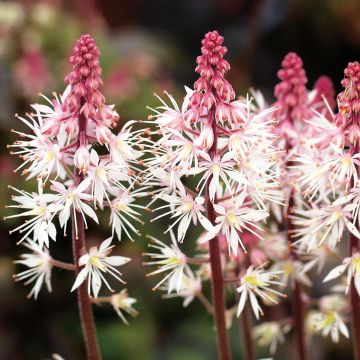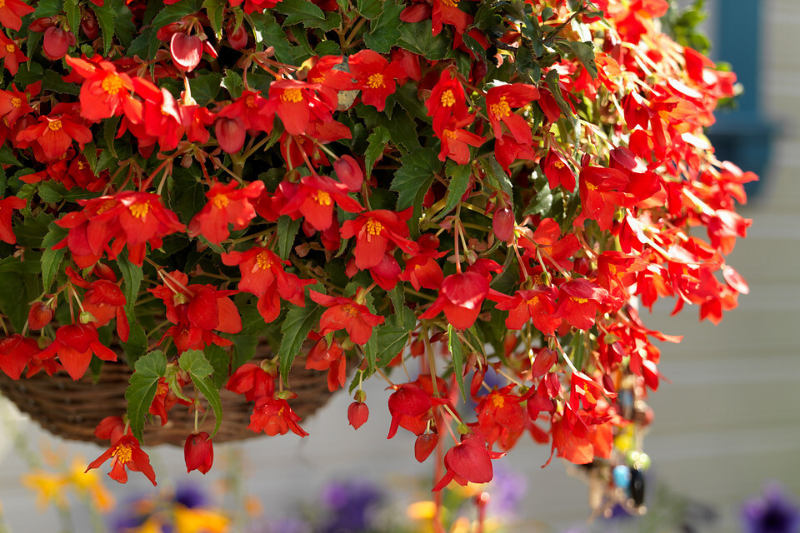

Wallflower - Erysimum cheiri Charity Mix
Wallflower - Erysimum cheiri Charity Mix
Erysimum x cheiri Charity Mix
Wallflower
Plant received 4 hours after ordering. Very good packaging. Planted immediately. Waiting for spring.
Christine, 09/11/2020
Special offer!
Receive a €20 voucher for any order over €90 (excluding delivery costs, credit notes, and plastic-free options)!
1- Add your favorite plants to your cart.
2- Once you have reached €90, confirm your order (you can even choose the delivery date!).
3- As soon as your order is shipped, you will receive an email containing your voucher code, valid for 3 months (90 days).
Your voucher is unique and can only be used once, for any order with a minimum value of €20, excluding delivery costs.
Can be combined with other current offers, non-divisible and non-refundable.
Why not try an alternative variety in stock?
View all →This plant carries a 6 months recovery warranty
More information
We guarantee the quality of our plants for a full growing cycle, and will replace at our expense any plant that fails to recover under normal climatic and planting conditions.

Would this plant suit my garden?
Set up your Plantfit profile →
Description
These biennial wallflowers or Erysimum cheiri 'Charity Mix' will flower from this autumn, and again in spring. The flowers, highly fragrant, come in various colours ranging from cream to yellow, orange, red, and old pink depending on the plants. Compact in habit, 'Charity' wallflowers are perfect for border planting, rockeries, or potting on the terrace.
Erysimum cheiri, also known as Cheiranthus cheiri, has gained different evocative vernacular names over the centuries and regions: it is sometimes called yellow wallflower, ravenelle, vélar, or yellow violier because it displays yellow flowers with a powerful clove scent, more intense in hot weather. It belongs to the family of crucifers or Brassicaceae, native to southern Europe, well adapted to rather dry limestone soils. Through hybridization, it has given rise to hardier and more perennial varieties, including the 'Charity' series. It is a short-lived perennial plant, more often cultivated as a biennial.
'Charity' wallflower is a compact variety, reaching approximately 30cm (11.8in) in height when flowering. It quickly forms upright tufts, bushy domes, with woody bases, covered in lanceolate leaves, sword-shaped, green, with a satin appearance. This foliage persists more or less in winter, depending on the intensity of the cold. The flowering begins in April and continues until early summer. The flower buds open into 4-petalled flowers whose color evolves depending on the temperature and age of the flower. Plants in the 'Charity' series bear flowers in a range of warm and varied tones. Measuring 3cm (1.2in) wide, they are highly fragrant in hot weather and gathered in racemes at the top of leafy stems. This flowering is highly visited by pollinating insects, who find one of the first spring nectars at the bottom of the corollas.
Appreciated in gardens for their easy cultivation and their propensity to self-seed in the most unlikely places, often abandoned by other plants, the wallflower and its cultivars are excellent rockery plants, which thrive even in somewhat infertile soils, and above walls. These plants also work wonders as border plants, alongside snapdragons, Damask Nigellas, Californian Poppies, evening primroses, or perennial flax. In a border of taller plants, for example, associate them with toadflaxes, mulleins, or other Gauras, as undemanding as they are. You can also grow 'Charity' wallflowers in pots on the terrace, balcony, near an entrance, to fully enjoy their generous flowering. Don't forget to water your pots regularly and provide them with flowering plant fertilizer.
Note: Please be aware that our young plants in plug trays are professional products intended for experienced gardeners: upon receipt, transplant them as soon as possible, in pots, containers, or directly in borders.
Report an error about the product description
Flowering
Foliage
Plant habit
Botanical data
Erysimum
x cheiri
Charity Mix
Brassicaceae
Wallflower
Cultivar or hybrid
Other Biennials A to Z
View all →Planting and care
Plant your 'Charity' wallflowers in early autumn or early spring, in a very sunny exposure. The soil should be properly loosened and well-drained. If necessary, coarse sand or gravel can be incorporated into the planting mix. This plant tolerates limestone and occasionally dry soils (which, however, affect flowering in summer), but it fears waterlogged soils in winter.
For container cultivation, a mix of ordinary soil, leaf compost, and sand or gravel should be used, without forgetting the drainage at the bottom of the pot (pot shards, small stones...). Water regularly but without excess. Remove faded flowers to encourage new blooms. The plant can be pruned back at the end of the season, leaving just portions of stems with 3 or 4 leaves. After 3 or 4 years, it will be necessary to replace the plant.
Planting period
Intended location
Care
Planting & care advice
-
, onOrder confirmed
Reply from on Promesse de fleurs
Similar products
Haven't found what you were looking for?
Hardiness is the lowest winter temperature a plant can endure without suffering serious damage or even dying. However, hardiness is affected by location (a sheltered area, such as a patio), protection (winter cover) and soil type (hardiness is improved by well-drained soil).

Photo Sharing Terms & Conditions
In order to encourage gardeners to interact and share their experiences, Promesse de fleurs offers various media enabling content to be uploaded onto its Site - in particular via the ‘Photo sharing’ module.
The User agrees to refrain from:
- Posting any content that is illegal, prejudicial, insulting, racist, inciteful to hatred, revisionist, contrary to public decency, that infringes on privacy or on the privacy rights of third parties, in particular the publicity rights of persons and goods, intellectual property rights, or the right to privacy.
- Submitting content on behalf of a third party;
- Impersonate the identity of a third party and/or publish any personal information about a third party;
In general, the User undertakes to refrain from any unethical behaviour.
All Content (in particular text, comments, files, images, photos, videos, creative works, etc.), which may be subject to property or intellectual property rights, image or other private rights, shall remain the property of the User, subject to the limited rights granted by the terms of the licence granted by Promesse de fleurs as stated below. Users are at liberty to publish or not to publish such Content on the Site, notably via the ‘Photo Sharing’ facility, and accept that this Content shall be made public and freely accessible, notably on the Internet.
Users further acknowledge, undertake to have ,and guarantee that they hold all necessary rights and permissions to publish such material on the Site, in particular with regard to the legislation in force pertaining to any privacy, property, intellectual property, image, or contractual rights, or rights of any other nature. By publishing such Content on the Site, Users acknowledge accepting full liability as publishers of the Content within the meaning of the law, and grant Promesse de fleurs, free of charge, an inclusive, worldwide licence for the said Content for the entire duration of its publication, including all reproduction, representation, up/downloading, displaying, performing, transmission, and storage rights.
Users also grant permission for their name to be linked to the Content and accept that this link may not always be made available.
By engaging in posting material, Users consent to their Content becoming automatically accessible on the Internet, in particular on other sites and/or blogs and/or web pages of the Promesse de fleurs site, including in particular social pages and the Promesse de fleurs catalogue.
Users may secure the removal of entrusted content free of charge by issuing a simple request via our contact form.
The flowering period indicated on our website applies to countries and regions located in USDA zone 8 (France, the United Kingdom, Ireland, the Netherlands, etc.)
It will vary according to where you live:
- In zones 9 to 10 (Italy, Spain, Greece, etc.), flowering will occur about 2 to 4 weeks earlier.
- In zones 6 to 7 (Germany, Poland, Slovenia, and lower mountainous regions), flowering will be delayed by 2 to 3 weeks.
- In zone 5 (Central Europe, Scandinavia), blooming will be delayed by 3 to 5 weeks.
In temperate climates, pruning of spring-flowering shrubs (forsythia, spireas, etc.) should be done just after flowering.
Pruning of summer-flowering shrubs (Indian Lilac, Perovskia, etc.) can be done in winter or spring.
In cold regions as well as with frost-sensitive plants, avoid pruning too early when severe frosts may still occur.
The planting period indicated on our website applies to countries and regions located in USDA zone 8 (France, United Kingdom, Ireland, Netherlands).
It will vary according to where you live:
- In Mediterranean zones (Marseille, Madrid, Milan, etc.), autumn and winter are the best planting periods.
- In continental zones (Strasbourg, Munich, Vienna, etc.), delay planting by 2 to 3 weeks in spring and bring it forward by 2 to 4 weeks in autumn.
- In mountainous regions (the Alps, Pyrenees, Carpathians, etc.), it is best to plant in late spring (May-June) or late summer (August-September).
The harvesting period indicated on our website applies to countries and regions in USDA zone 8 (France, England, Ireland, the Netherlands).
In colder areas (Scandinavia, Poland, Austria...) fruit and vegetable harvests are likely to be delayed by 3-4 weeks.
In warmer areas (Italy, Spain, Greece, etc.), harvesting will probably take place earlier, depending on weather conditions.
The sowing periods indicated on our website apply to countries and regions within USDA Zone 8 (France, UK, Ireland, Netherlands).
In colder areas (Scandinavia, Poland, Austria...), delay any outdoor sowing by 3-4 weeks, or sow under glass.
In warmer climes (Italy, Spain, Greece, etc.), bring outdoor sowing forward by a few weeks.




























































